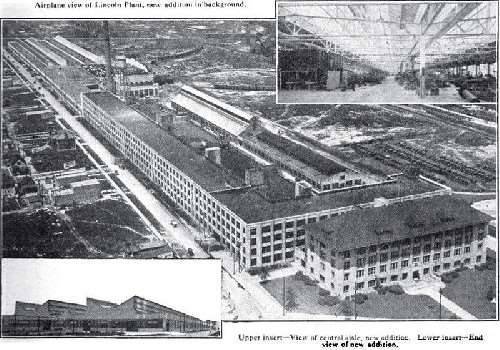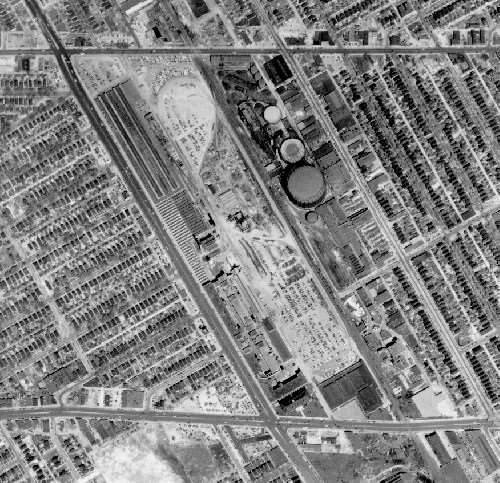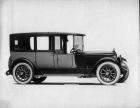|
Re: New "What Ifs?"
|
||||
|---|---|---|---|---|
|
Home away from home

|
Here's another one, re Conner
Ward says that Nance was able to raise $7.5M in loans to finance the purchase of Conner. But then Chrysler demanded $8.75M, then sqeezed Packard for another $500,000. Which resulted in Packard leasing instead. What other big plant was available in 53-54, other than Willow-Run, which was way too big, where Packard could build and paint bodies, then final assemble the cars? In 52, the Lincoln-Mercury division moved to new digs in Wayne, leaving it's plant at 6200 W Warren. By eyeball, the "old" 4 story section of the plant is some 700,000sqft, while the "new" (1923) single story section is 311,000sq ft according to a blurb in the Ford Times of that year. I eyeball that "new" section as 1200' long. All together, about a million sqft of manufacturing space, designed for auto production. And significant expansion room on the east side of the plant. What could the old Lincoln plant be had for? In 55, Ford sold it to DTE for $4.5M. Half what Chrysler wanted for the smaller Conner plant. With a plant with body building space in hand, all Nance would have to do is scrounge stampings from Budd and Murray.
Posted on: 2014/8/17 21:16
|
|||
|
||||
|
Re: New "What Ifs?"
|
||||
|---|---|---|---|---|
|
Home away from home

|
What about the Utica plant?
Packard sank $15M into that plant. Probably didn't get it's money back from the J47 contract. Moved powertrain into it, probably only because it was there, as the powertrain machine shops at EGB still stood. The flim about the 25,000 mile durability test kind of glosses over the point that EGB "was not suitable". So how to get their money out of Utica, other than selling it to one of the big three, giving them a really comfortable place to watch goings on at PPG? First possibility: Kelsey Hayes. Kelsey did move into a new plant in Romulus in 59. Would they be up to a move 5 years earlier? Would they like the idea of having their headquarters and plant right next to a test track? *ring ring* Packard "Packard proving ground" K-H: "we would like to run some brake tests" Packard: "fine, I'll be over to unlock the gate in a few minutes, just pay the usual fee of $200/hr to Packard" When Studebaker packed it in in South Bend, Bendix bought the Studie proving ground in a hot second. Second possibility. in the April 9, 1954 issue of Flight is an article about Curtiss-Wright negotiating to buy a plant the government built for the aborted J40 engine program to expand production of C-W's very successful J65. Ultimately C-W's negotiations for that plant were unsuccessful because that was the plant in Romulus that Kelsey bought. Would C-W be even more interested in Utica, which was already equipped for jet engine production, and which C-W ended up in anyway 2 years later, with a J57 contract as part of the S-P bailout.
Posted on: 2014/8/17 21:30
|
|||
|
||||
|
Re: New "What Ifs?"
|
||||
|---|---|---|---|---|
|
Forum Ambassador
|
S-Ps big dream, post Mason-envisioned AMC that never happened was to build a new single floor assembly plant in Utica on land to the immediate north (as in attached to) the Utica engine plant, for what would have amounted to "big car" assembly, e.g. all Packard/Clipper and Hudson models sharing the big car black metal.
The Lincoln plant on the west side wouldn't have been a bad place to land, and the price per sq. ft. was within reason.
Posted on: 2014/8/18 9:13
|
|||
|
||||
|
Re: New "What Ifs?"
|
||||
|---|---|---|---|---|
|
Home away from home

|
S-Ps big dream, post Mason-envisioned AMC that never happened was to build a new single floor assembly plant in Utica
Too bad so much documentation was burned when EGB was closed. I have heard that they planned a modern assembly plant in Utica repeatedly, but, at least I, have never seen documentation that that was the plan when the J47 plant was built. Packard won that contract largely because of their performance on the Merlin contracts and their jet engine research in Toledo in the late 40s, though the Toledo team had long since dispersed. The initial contract for 3,000 engines was increased to 6,000 on June 24, 52. The Air Force spent $48M equipping the plant. From material I have seen, Packard figured good performance on this contract could result in additional contracts. As long as Packard figured they had a shot at further jet engine contracts, with their guaranteed profits, I can't imagine them ever planning on moving powertrain in there. I suspect the powertrain move was a decision made on the fly when the J47 business fizzled. It's just interesting that, just as Packard's J47 operation was circling the drain, Curtiss-Wright was on the hunt for a jet engine plant....but Nance had Ray Powers buzzing in his ear to get into a one story plant. Actually, building a greefield assembly plant would have been a huge undertaking for Packard. Unfortunately, the article I found some time ago about the new Lincoln plant in Wayne didn't say how much it cost to build and equip, but Ford and GM could write checks that Packard couldn't even dream of. A plan that would have been eaiser on the checkbook would have been to start buying up houses across Concord from EGB and build in phases: first a body assembly and paint plant, then throw a conveyor over Concord to feed the bodies into the body trim line in building 35. Then build a stamping plant next to the body plant. Carry on in this manner until everything has been replaced.
Posted on: 2014/8/18 17:00
|
|||
|
||||
|
Re: New "What Ifs?"
|
||||
|---|---|---|---|---|
|
Home away from home

|
A lot of this is selling Packard very short on their really BIG dreams and some of the direction based on their expertise in building jet engines and advancing that technology.
As I mention in my Packard Concept Car Presentation, JJN and Packard were not planning on standing still with engines and future technologies. The unveiling of the beautiful new 1955 Packards with all of their stunning technology (and it WAS stunning in 1955-no matter what people say today in retro-judgements) was just the opening salvo. The Torsion-Level suspension alone was such a stunning masterpiece that to this very day, car companies have yet to surpass it. They STILL talk about anti-dive, anti-squat, and electronic leveling as if these concepts are something completely new! And people (even in Packard groups) continue to badmouth the Twin Ultramatic... but an electronic push-button aluminum transmission with a lock-up converter in 1956? THAT was way out there. Had these technologies and systems had more time and funding for development the possibilities were endless. Of course, talk of a new twelve... plans to go to fuel injection for 1957... and by the 1960s there were plans to go to gas turbine engines. I can tell you that some former Packard people indeed ended up doing this very thing... for Chrysler under George Huebner. Assure you that personnel and Packard jet engine building facilities and experience would have blended right into this direction. Utica would have played a valuable part here. Yes, there is a lot of woulda-coulda-shoulda here... but it was all very possible had not so many factors led the company to demise. Of course, automotive gas turbines were shot in the foot every direction they turned... despite their many advantages. There is much more to this story than anyone knows-or will ever know. But had Packard survived-and this is NEVER mentioned in histories referencing the company-they would have played an important role in this technology as well.
Posted on: 2014/8/19 10:46
|
|||
|
||||
|
Re: New "What Ifs?"
|
||||
|---|---|---|---|---|
|
Home away from home

|
<i>A lot of this is selling Packard very short on their really BIG dream and some of the direction based on their expertise in building jet engines and advancing that technology.</i>
Packard did fantastic work in jet engines in the late 40s. The Packard team in Toledo invented the fan jet, the type of engine we see on every jet airliner in use today. Overview of Packard's work in Toledo http://www.enginehistory.org/members/articles/PackardGasTurbines.pdf Wiki article on the XJ49 fanjet. http://en.wikipedia.org/wiki/Packard_XJ49 In the late 40s, the government was subsidizing jet engine development at a number of companies. The government decided it didn't need so many companies developing jets, and Packard's subsidy was eliminated. Unable to fund the development itself, Packard closed the shop in 49 and the development team members went their seperate ways. The Toledo plant, which is government owned, stood idle until Contiental CAE, then headquartered on Kercheval, behind the engine plant on Jefferson, in Detroit, won a contract in 55 to make engines for the Air Force T-37 trainer. CAE occupied the plant and made small jets there for years, for the T-37 and cruise missles. http://en.wikipedia.org/wiki/Teledyne_Turbine_Engines
Posted on: 2014/8/19 11:20
|
|||
|
||||
|
Re: New "What Ifs?"
|
||||
|---|---|---|---|---|
|
Home away from home

|
Utica would have played a valuable part here. Yes, there is a lot of woulda-coulda-shoulda here... but it was all very possible had not so many factors led the company to demise.
There was a lot of attrition in the US jet engine business in the 50s, so the odds were stacked against Packard, even if it had had more money. Westinghouse was an early player and developed the J40 for the Navy. The government built a plant on Northline Rd in Romulus for the Lincoln-Mercury division to build J40s under contract. Westinghouse was never able to get the J40 to perform to specification, and the program's failure played a large part in Westinghouse's withdrawl from the jet engine business. With the early termination of the J40 program, Ford's contract to build them was cancelled on April 16, 53. The Northline Rd plant sat unused, until Kelsey-Hayes bought it in 59. This was also the plant that Curtiss-Wright was sniffing around at in April 54. Curtiss also failed to make the transition to jets, in spite of Wright radials having been a major force in the industry for decades. The J65 was a license built version of the Armstrong Siddeley Sapphire, and apparently worked quite well. C-W had however been dogged by poor product quality for years. The company was investigated for knowingly shipping defective engines during the war. By one account, the quality issues persisted through the 50s, resulting in the government dropping C-W from it's supplier list, which contributed to C-W selling Utica in 61. With companies the size of Westinghouse and Curtiss-Wright not being able to stay in the jet engine business, Packard, with it's lack of resources, didn't stand a chance.
Posted on: 2014/8/19 11:53
|
|||
|
||||
|
Re: New "What Ifs?"
|
||||
|---|---|---|---|---|
|
Home away from home

|
Hello, yes, but the engines I am talking about were not aircraft, but rather automotive gas turbines. Which also are often-to this day-confused with jet engines. A gas turbine produces power output usually via a shaft (its aircraft application would be in a turbo-prop or helicopter). A jet's power is via its exhaust. It pushes with its exhaust.
While some people use these terms interchangeably, they are two different animals that share much the same technology and operational principles. I am one of few people who drove several gas turbine automobiles. Among these were the Chrysler Ghia Gas Turbines and the Turbine Aspen DOE car. Somewhere lurking deep inside these cars was just a touch of Packard. And again, when we start talking about Packard and "what-ifs"... the Packard automotive gas turbine cars would have been the biggest "what-ifs" of all...! Bad enough that Chrysler's program-as far as it went-was killed off. But it is a crying shame that we never got to see what Packard would have, should have, and could have been allowed to do with this technology. That would have been a show-stopper!
Posted on: 2014/8/19 12:26
|
|||
|
||||
|
Re: New "What Ifs?"
|
||||
|---|---|---|---|---|
|
Home away from home

|
I am talking about were not aircraft, but rather automotive gas turbines.
Problem is gas turbines have never caught on for surface transportation. I remember the Chrysler and Rover turbine cars. In the early 70s, Ford was experimenting with a turbine in a long haul truck. Union Pacific had a few turbine powered freight engines. Then there were the Turboliners that Amtrak had in the early 70s. They all went away when fuel prices rose. Where gas turbines caught on in a big way, and where Packard had a good start was for aircraft. Packard's XJ49 was one of the most powerful jets of it's day, with takeoff thrust of 12,000lbs. That makes it the equal of the Pratt J57, which first ran 4 years later, and being a turbofan, the XJ49 probably had fuel consumption 20-25% lower than the J57. Being developed sooner, and being more fuel efficient, which translates into more range and/or more payload, it could have been used instead of the J57, or it's civilian variant JT3C, on several subsonic platforms, namely the early models of B52, KC135, 707, DC8 and several other less well known military and civilian aircraft. Pratt built over 20,000 J57/JT3Cs. That business could have been Packard's, if they had had the resources to develop and produce the XJ49.
Posted on: 2014/8/20 0:17
|
|||
|
||||

 (102.25 KB)
(102.25 KB)








